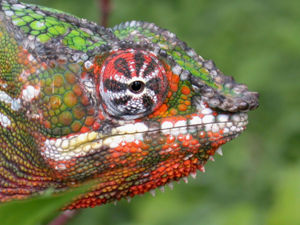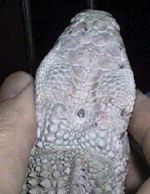Difference between revisions of "Lizard Eye"
| Line 1: | Line 1: | ||
| + | {{OpenPagesTop}} | ||
==Introduction== | ==Introduction== | ||
[[Image:Panther_Chameleon.jpg|300px|thumb|right|'''Panther chameleon spectacle''' (© Tom Junek, Wikimedia Commons)]] | [[Image:Panther_Chameleon.jpg|300px|thumb|right|'''Panther chameleon spectacle''' (© Tom Junek, Wikimedia Commons)]] | ||
| Line 47: | Line 48: | ||
{{review}} | {{review}} | ||
| + | |||
| + | {{OpenPages}} | ||
| + | |||
[[Category:Lizard Anatomy|E]] | [[Category:Lizard Anatomy|E]] | ||
[[Category:Expert Review - Exotics]] | [[Category:Expert Review - Exotics]] | ||
Revision as of 18:17, 26 July 2012
Introduction
Common mydriatics have no effect on the reptilian eye because both the iris sphincter and ciliary muscle contain striated (or skeletal) rather than smooth muscle. This means that they are under conscious control. Therefore, unlike mammals, the consensual pupillary response is absent, the cornea does not contain a Descemets membrane and scleral ossicles are often present. This renders the ocular examination more challenging but more importantly, the parasympatholytic topical drugs (that reduce the activity of the parasympathetic nervous system) used to dilate the pupil mydriasis) in mammals are totally ineffective.
Another characteristic of the lizard eye is its ability to occupy both scotopic (light limited) and photopic (light rich) environments. Indeed, the morphology of the eye adapts and varies according to activity in these different light environments.
- For information on examination of the eye, see Lizard Physical Examination.
Parietal Eye
Also Known As: Pineal Eye — Third Eye
A well developed parietal "eye" (with a rudimentary lens and retina) is found on the dorsal midline in some lizards, including the green iguana, blue-tongued skink and water dragon.
This sensory organ is connected to the central nervous system and the pineal gland by the small parietal nerve. It functions in hormone production (including reproduction) and thermoregulation (by acting as a light dosimeter). It detects both UV light and heat. Although sensitive to changes in light, it cannot form images. By detecting light and dark it allows lizards to detect the movement of predators. Sometimes referred to as "pineal eye" or "third eye", it it visible as an opalescent gray spot on the top of some lizard's heads.
Eyelids
They are usually present. The lower lid is movable, moving upwards to close the eye; in some lizards, this lid might be transparent, allowing vision even when the lids are closed. Lizard also have a well developed, semi-transparent, highly mobile third eyelid which is called the 'nictitating membrane'; this membrane can close across the eye even while the eyelids remain open.
In some chameleon species as well as some geckos and the oscellated skink (Ablepharus sp.) the eyelids have fused to produce a circular, immobile and transparent dermal aperture called a spectacle. It create an impervious barrier to topically applied medications.
Pupil
The pupil is usually round and relatively immobile in diurnal species and is usually slit-like in nocturnal species. Geckos, such as the Tokay gecko, have a serrated pupillary opening resembling a series of small holes when the pupil is completely closed. This specificity allows for acute vision even in dim light.
Behaviour
When threatened or molested by other animals, such as dogs, coyotes or foxes, certain horned lizards (Phrynosoma cornutum, P. coronatum and P. solare) will respond by squirting a spectacular amount of blood from their eyes. They accomplish this by constricting venous outflow from the head which increases blood pressure and causes leakage from the ocular venous sinuses.
- For more information on behaviour, see Lizard Behaviour.
| Lizard Eye Learning Resources | |
|---|---|
 Test your knowledge using flashcard type questions |
Reptiles and Amphibians Q&A 16 |
References
- Engbretson, G.A. & Lent, C.M. (1976). Parietal eye of the lizard: neuronal photoresponses and feedback from the pineal gland. Proceedings of the National Academy of Sciences 73, 654-657
- Fowkes, R (2008) Endocrinology of Special Species BVetMed Integrated Course RVC
- Frye, FL & Williams, DL (1995) Self-Assessment Colour Review - Reptiles & Amphibians Manson
- Girling, S.J. (2004). BSAVA Manual of Reptiles. British Small Animal Veterinary Association. pp. 350. ISBN 0905214757
- Hall, M.I. (2008). Comparative analysis of the size and shape of the lizard eye. Zoology 111, 62-75
- Mader, D.R. (2005). Reptile Medicine and Surgery. Saunders. pp. 1264. ISBN 072169327X
| This article has been peer reviewed but is awaiting expert review. If you would like to help with this, please see more information about expert reviewing. |
Error in widget FBRecommend: unable to write file /var/www/wikivet.net/extensions/Widgets/compiled_templates/wrt6932dd6d616a57_06329526 Error in widget google+: unable to write file /var/www/wikivet.net/extensions/Widgets/compiled_templates/wrt6932dd6d7b0352_66254142 Error in widget TwitterTweet: unable to write file /var/www/wikivet.net/extensions/Widgets/compiled_templates/wrt6932dd6d8e1060_69182426
|
| WikiVet® Introduction - Help WikiVet - Report a Problem |


